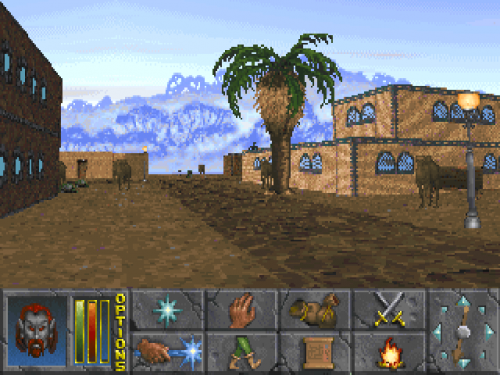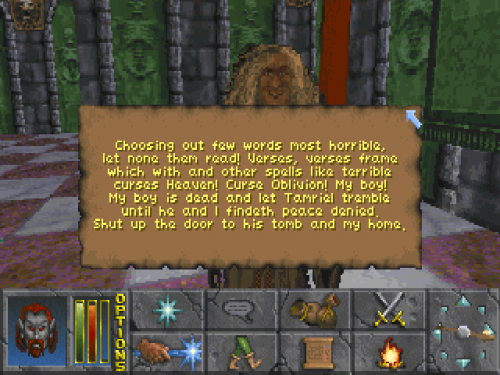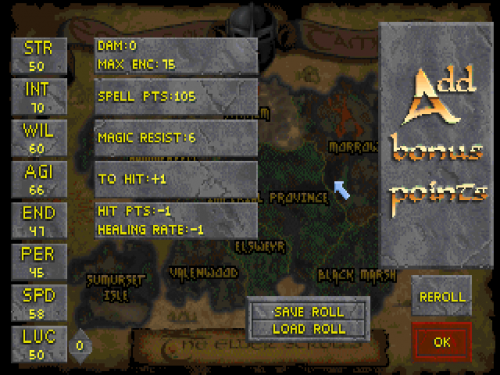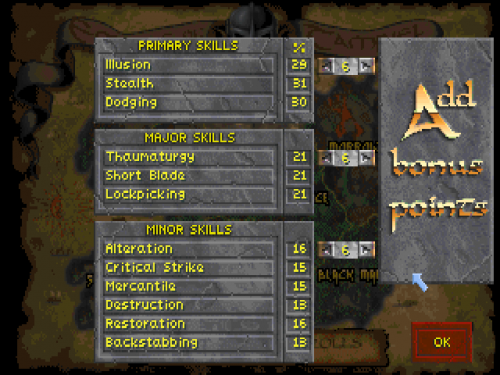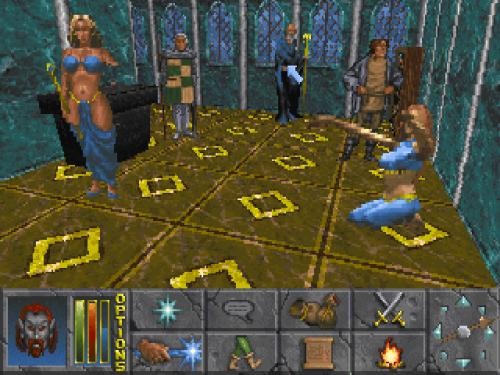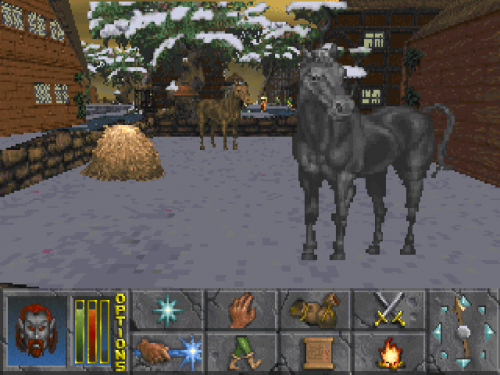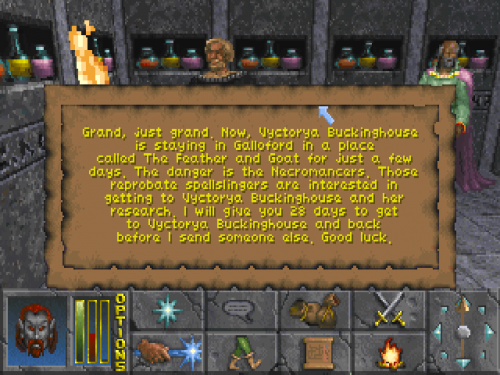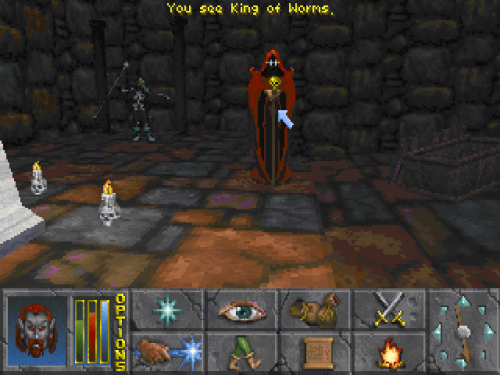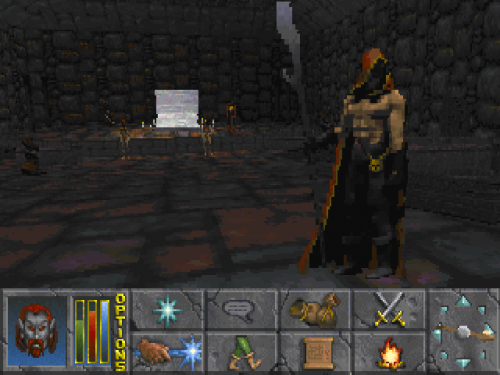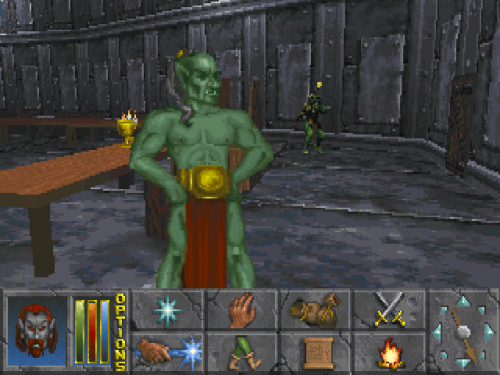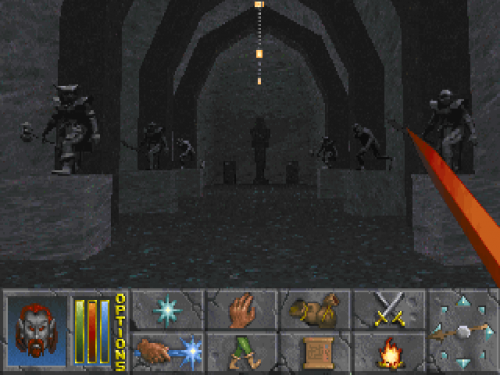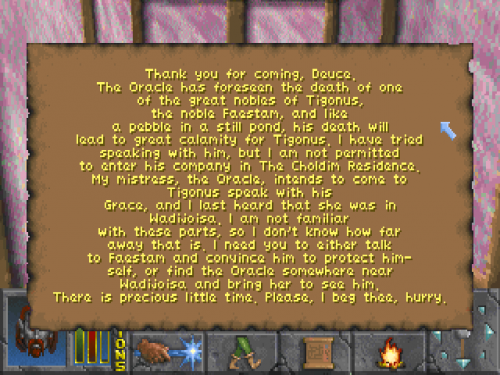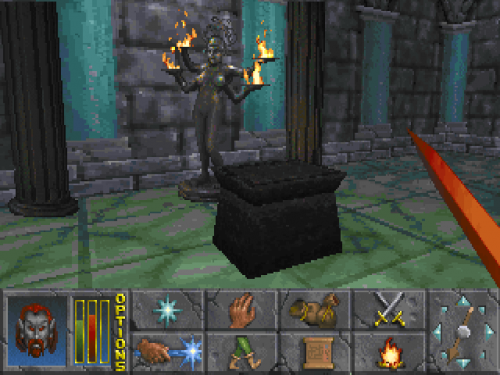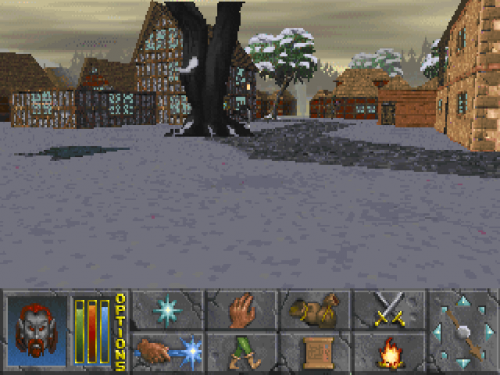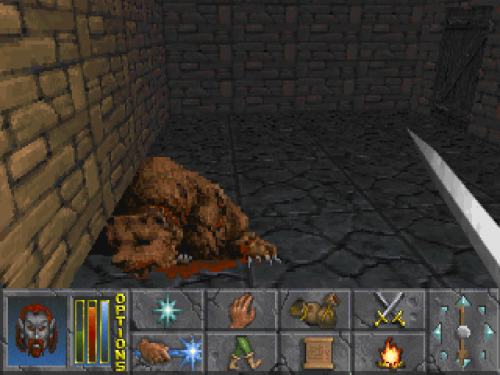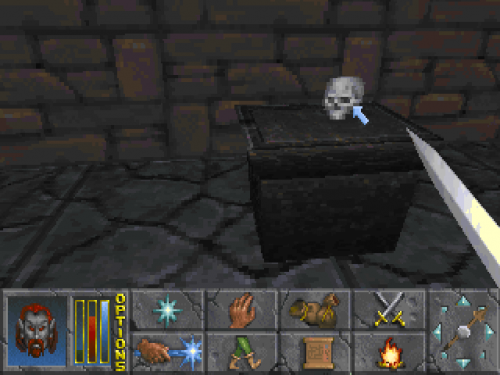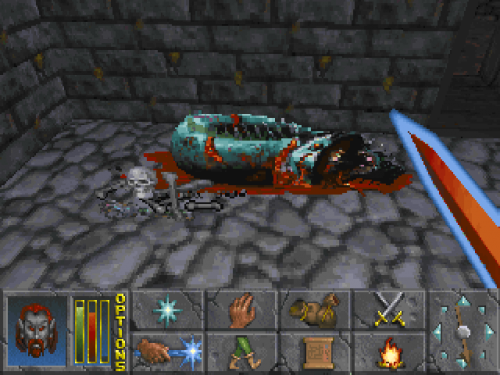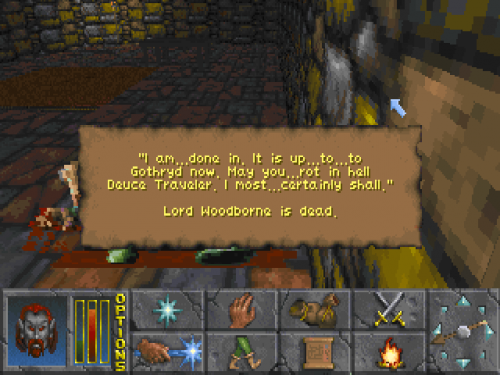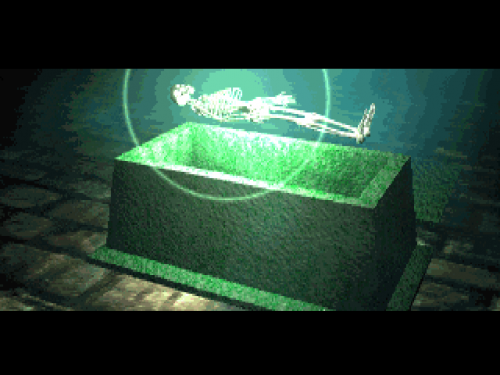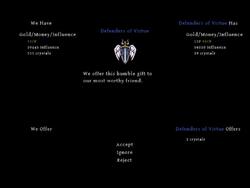RPG Codex Retrospective Review: The Elder Scrolls II: Daggerfall (1996)
RPG Codex Retrospective Review: The Elder Scrolls II: Daggerfall (1996)
Review - posted by Crooked Bee on Wed 22 July 2015, 16:48:32
Tags: Bethesda Softworks; The Elder Scrolls II: DaggerfallAfter reviewing Arena, the Elder Scrolls game that started it all, esteemed community member Deuce Traveler now moves on to the 1996 The Elder Scrolls: Daggerfall. Daggerfall is famous, or infamous, for both its scope and its sprawling randomized dungeons, which I dearly loved, but how does it fare today?
Deuce Traveler has all the answers.
Read the full article: RPG Codex Retrospective Review: The Elder Scrolls: Daggerfall (1996)
Deuce Traveler has all the answers.
Ah, Daggerfall. Both stunning in its depth and a hot mess when it comes to its glaring bugs. It's a game which doesn’t deserve the hype lavished on it by its nostalgic fans, despite being groundbreaking for its time. I spent months playing it, and my feelings continually wavered between frustration and amazement. I found Arena to be more fun, but Daggerfall to be better structured. I found Morrowind to be more immersive, but Daggerfall’s main plot to be more interesting. There is one thing that most of us can agree upon, though - it’s a better game than Oblivion.
[...] No review of Daggerfall is truly complete without mentioning the massive amount of pixelated boobs that this game provides. And no, I’m not talking about fools. I’m talking tits, jugs, gazongas, hooters, knockers, fun bags, bazoombas, cha-chas, num-nums, cantaloupes, flapdoodles, mounds, torpedoes, rack, neeners, soombas, mammaries and milk bombs. They are simply everywhere, although they do change from location to location. If you're a religious type, the finest examples can be found in temples dedicated to Kynareth, goddess of air, and Dibella, goddess of love (and there are also barechested men in Dibella’s temples for all the female gamers out there). The sophisticated aficionado can also find a varied assortment of bare sweater puppies in personal chambers inside castles, at some mage guilds, on monsters in dungeons and among the daedra princesses. Unfortunately, we would have to wait until The Witcher to get in-game collectible cards, but there’s always CTRL-F5 in DOSBox. I used to think that some of those Oblivion mods went a bit over the top, but after playing Daggerfall, it's tempting to view them as a return to form.
[...] I will admit that some of the side quests are complex in clever ways. One quest that stood out for me was a Knights of the Dragon quest where I was asked to help a witch hiding in the depths of a dungeon. Upon finding her, she tasked me with locating and delivering a young girl to her to so that she could become the witch's apprentice. I took up the quest, but when I approached the girl she screamed for help and I found myself in a running battle with the nearby guards who followed me all the way to the dungeon. After delivering the girl, I still had to fight my way out of the dungeon, I took a reputation hit with the local people, and the next time I talked to a random child I was told off by the little tyke. All this was quite clever, but also a bit messed up. The leadership of the Knights of the Dragon distrusts magic-users, so why this was one of their faction quests is still a mystery to me. Once I realized I was kidnapping the girl, I could have turned her over to the authorities and asked for forgiveness, but that would have resulted in a loss of reputation points with the knighthood for the failed quest, instead of being rewarded for making the more moral, citizen-friendly decision. Also, the witch was near an underwater cavern, so to get to her I had to swim through a crowd of soldiers who were standing in place waiting for me on the pool floor without drowning. Have I mentioned that the citizens of Daggerfall's cities can walk on water? In summary, the copy-and-paste nature of Daggerfall's side quests and dungeons leads to an endless stream of glitches and nonsensical moments that emphasizes the game's design flaws, harming immersion more than it helps it.
[...] No review of Daggerfall is truly complete without mentioning the massive amount of pixelated boobs that this game provides. And no, I’m not talking about fools. I’m talking tits, jugs, gazongas, hooters, knockers, fun bags, bazoombas, cha-chas, num-nums, cantaloupes, flapdoodles, mounds, torpedoes, rack, neeners, soombas, mammaries and milk bombs. They are simply everywhere, although they do change from location to location. If you're a religious type, the finest examples can be found in temples dedicated to Kynareth, goddess of air, and Dibella, goddess of love (and there are also barechested men in Dibella’s temples for all the female gamers out there). The sophisticated aficionado can also find a varied assortment of bare sweater puppies in personal chambers inside castles, at some mage guilds, on monsters in dungeons and among the daedra princesses. Unfortunately, we would have to wait until The Witcher to get in-game collectible cards, but there’s always CTRL-F5 in DOSBox. I used to think that some of those Oblivion mods went a bit over the top, but after playing Daggerfall, it's tempting to view them as a return to form.
[...] I will admit that some of the side quests are complex in clever ways. One quest that stood out for me was a Knights of the Dragon quest where I was asked to help a witch hiding in the depths of a dungeon. Upon finding her, she tasked me with locating and delivering a young girl to her to so that she could become the witch's apprentice. I took up the quest, but when I approached the girl she screamed for help and I found myself in a running battle with the nearby guards who followed me all the way to the dungeon. After delivering the girl, I still had to fight my way out of the dungeon, I took a reputation hit with the local people, and the next time I talked to a random child I was told off by the little tyke. All this was quite clever, but also a bit messed up. The leadership of the Knights of the Dragon distrusts magic-users, so why this was one of their faction quests is still a mystery to me. Once I realized I was kidnapping the girl, I could have turned her over to the authorities and asked for forgiveness, but that would have resulted in a loss of reputation points with the knighthood for the failed quest, instead of being rewarded for making the more moral, citizen-friendly decision. Also, the witch was near an underwater cavern, so to get to her I had to swim through a crowd of soldiers who were standing in place waiting for me on the pool floor without drowning. Have I mentioned that the citizens of Daggerfall's cities can walk on water? In summary, the copy-and-paste nature of Daggerfall's side quests and dungeons leads to an endless stream of glitches and nonsensical moments that emphasizes the game's design flaws, harming immersion more than it helps it.
Read the full article: RPG Codex Retrospective Review: The Elder Scrolls: Daggerfall (1996)
[Review by Deuce Traveler]
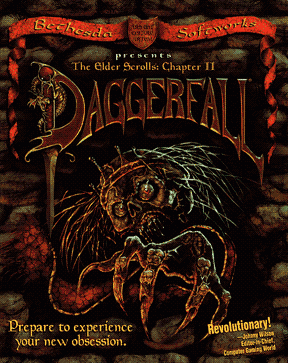
Ah, Daggerfall. Both stunning in its depth and a hot mess when it comes to its glaring bugs. It's a game which doesn’t deserve the hype lavished on it by its nostalgic fans, despite being groundbreaking for its time. I spent months playing it, and my feelings continually wavered between frustration and amazement. I found Arena to be more fun, but Daggerfall to be better structured. I found Morrowind to be more immersive, but Daggerfall’s main plot to be more interesting. There is one thing that most of us can agree upon, though - it’s a better game than Oblivion.
Daggerfall's main plot surpasses that of Morrowind to become my favorite in the Elder Scrolls series. Typically, an RPG plot involves your character turning out to be some kind of chosen one prophesized to save the kingdom, rescue a ruler or beautiful princess, defeat an ancient evil, or some combination of those familiar tropes. In contrast, in Daggerfall you play an Imperial agent, sent to investigate the murder of a Breton king and find out what happened to a secret message sent by the Emperor to a trusted member of the nobility. From that premise, an intricate backstory is revealed involving treason, political maneuvering, adultery, murder and other unsavory acts. The gradual reveals do much to help flesh out the politics and turbulent history of this region of Tamriel.
In order to ensure your survival, you’ll need to create a character that can stand up to the challenge. Daggerfall has one of the most satisfying character systems in the genre, with eight attributes, eight races, dozens of skills, as well as numerous special advantages and disadvantages to choose from, which grant your character additional bonuses and maluses. Some classes, such as the Sorcerer, can stand well enough on their own without much tweaking, but you can create a more efficient custom character class to fit your own style of gameplay. If character creation is too confusing for you, there's also an option to build a character by answering a slew of multiple choice questions about your character's personality and history. The end result will be a character with three primary skills that you will want to rely on the most, along with some major and minor skills to back him up. The rest of the skills will get tossed into a miscellaneous bucket, and start off quite low. As for special advantages, they include bonuses to hit chance and damage, quicker healing, resistance to certain elements or status effects, spell absorption and so on. The more advantages you choose, however, the slower you'll level up (which might actually not be such a bad thing if you plan to spend a couple hundred hours in a game with level-scaling). The special disadvantages allow you to balance out the experience penalty from your advantages. They include forbidden equipment materials, vulnerability to certain attacks, and more.
Honestly, you should always give your characters the best Increased Magery special advantage, which gives you a maximum magicka score equal to triple your Intelligence. Most characters start with maximum magicka equal to half their intelligence score, so even reaching 100 points in Intelligence means that they will only be able to cast spells that require 50 points of magicka or less. This makes it impossible for most of the default character classes to cast the most useful spells, including the spells for opening locks and resisting magic. It is possible for a wizard character to gradually build up a melee skill to its maximum level, but no matter what you do, your fighter will never be able to cast a spell that requires over 50 magicka points. The former is good news, because even with the Increased Magery advantage, spellcasters still run out of magicka often and have to fall back to melee weapons to defeat their enemies.
Character progression occurs as your character improves his primary, major and minor skills. Advance your skills enough, and your character will level up, allowing you to invest around 4-6 points into your attribute scores, up to a maximum of 100 per attribute. Daggerfall does a good job of making each attribute important, so there aren't really any dump stats, although there will be some that you'll deem less important than others.
Most Daggerfall characters are going to depend on one armor type, one melee weapon type, and one ranged weapon type, and the rest of their skills are probably going to involve spellcasting. In other words, regardless of initial character creation choices, your typical character is going to end up as a warrior-wizard hybrid of some sort. You can forget about being a diplomat or a pure rogue, as it will be prohibitively difficult to win the game using only stealth, diplomacy, or lockpicking skills. Speaking of which, skill progression seems to work in an odd way. For example, when I had around 20 skill points invested into my lockpick skill, I was very rarely able to unlock doors, as opposed to the 20% chance I thought I would have. However, once this same skill was brought up to the mid-40s, I was able to easily unlock the vast majority of locked doors I encountered. Meanwhile, my language skills rarely increased, and it was often difficult to determine if a particular monster had decided not to attack me due to those skills or due to stealth. In short, the exact formulas used to determine skill usage success rates in Daggerfall are a mystery.
No review of Daggerfall is truly complete without mentioning the massive amount of pixelated boobs that this game provides. And no, I’m not talking about fools. I’m talking tits, jugs, gazongas, hooters, knockers, fun bags, bazoombas, cha-chas, num-nums, cantaloupes, flapdoodles, mounds, torpedoes, rack, neeners, soombas, mammaries and milk bombs. They are simply everywhere, although they do change from location to location. If you're a religious type, the finest examples can be found in temples dedicated to Kynareth, goddess of air, and Dibella, goddess of love (and there are also barechested men in Dibella’s temples for all the female gamers out there). The sophisticated aficionado can also find a varied assortment of bare sweater puppies in personal chambers inside castles, at some mage guilds, on monsters in dungeons and among the daedra princesses. Unfortunately, we would have to wait until The Witcher to get in-game collectible cards, but there’s always CTRL-F5 in DOSBox. I used to think that some of those Oblivion mods went a bit over the top, but after playing Daggerfall, it's tempting to view them as a return to form.
The world of Daggerfall is very large, and filled with settlements and dungeons. According to the always trustworthy Internet, it is equivalent in size to Great Britain, though I admit I used the fast travel system instead of trying to verify this claim by walking from one end of the country to the other. Fast travel on the world map is a fairly simple affair. You click on the province you are interested in for a closer view, then click on the desired destination and decide if you want to travel there at a fast pace, or take your time and arrive later, healed and refreshed. There is also an option to type in the name of the destination you are looking for, in case you don’t want to move your mouse cursor over every little off-colored pixel designating a location, which can be difficult.
The different regions of this corner of Tamriel each have their own environments and architectural styles. The hotter regions are full of deserts, with beige-colored buildings that appear as if they were made from sandstone, while locations such as the city of Daggerfall have green fields and fortresses that look more Western European in design. Although every citizen of these settlements has a unique name, the vast majority of them lack depth or personality. There's a conversation system, where you can try to be polite, blunt or speak normally, which has some effect on how they respond to you. The citizens can offer you recent news, but their real function seems to be to point out directions, as the city map doesn’t tell you where any building or person you are looking for might be located. Important buildings are only identified when you enter one, read the sign next to it, or ask a citizen who is kind enough to mark it on your map. This design decision brings some realism into the game, but can slow the experience down to the point of being a chore, as you’ll often need to speak to multiple people before you get to your desired location, unless you improve specific social skills.
Members of noble families, faction representatives and quest givers act differently from cookie-cutter citizens, staying in a single spot and waiting for you to ask for training, exposition, quest progression, and other such things. At the beginning of your adventure, the people you interact with will tend not to like your character very much. However, the game implements a faction-based reputation system, and as you take on quests to help the people of Daggerfall, you'll notice them becoming friendlier and more willing to help. The factions covered by this system include not only regions, but also various guilds and criminal organizations. Doing a dirty deed for the Queen of Sentinel might improve your status among the people of the city, but it could also anger those working for the undead King of Worms or a rival noble family. This doesn’t have to be permanent, however, as you can travel to their fortresses and perform tasks that might make them warm up to you too.
The region of Tamriel in which Daggerfall takes place is separated by a large bay, and so it can be travelled by foot, horse, cart or ship, the last three options being faster, if you're willing to pay the price. The cities of Daggerfall might seem safe, but you can get yourself in deep trouble in them with an innocent mistake, such as trying to sleep in the streets during the night because you're waiting for a business to open up. If you can’t pay the fine when the guards find you, you can end up in jail, where you'll lose skill points due to inactivity. The alternative is fighting or fleeing from the guard, which risks your reputation. Oh, and if you try to loiter in town to pass time, the game only lets you do so three hours at a time, because the feature was designed by sadists who were having a bad day I guess. This limitation has apparently managed to solve Tamriel's homelessness problem though, as it was much easier to find beggars in The Elder Scrolls: Arena than in Daggerfall. In between the cities and towns can be found dungeons, as well as out-of-the-way homes and temples. The temples don’t have much going for them, except that you can get healed in them if you're infected by a life-threatening disease and are too far away to make it to a city temple, or if you want to go on a random fetch quest. It's the dungeons which will be occupying the majority of your exploration time.
Daggerfall's dungeons are huge, and can easily take a couple of hours each to fully explore. At first they seem fairly interesting - filled with pit traps, secret levers masquerading as simple torches, hidden doors with treasure vaults behind them, static items such as skulls and chains that grant magical effects ranging from levitation to dangerous fireballs, and water-filled passageways guarded by carnivorous eels. To survive, you have to be able to jump, run, sneak and strike when the situation calls for it. The problem comes after the first two or three dungeons that you clear out, when you begin to realize there is very little real change from one to the next. The larger chambers in-between the dungeon corridors are copied and pasted endlessly, with only their orientations and connecting passages changing. So the first time you find yourself on a U-shaped ledge overlooking a chamber below you with a lever and an altar at the center, it’s pretty cool. When you see the exact same chamber a dozen more times with only the enemies changing, it loses its charm. The game's final dungeon is thankfully quite unique, but unfortunately it leans a bit on the action platformer side of things in some portions, because everybody knows computer roleplaying games and action platformers mix so darn well.
The same cookie-cutter approach used for the majority of the dungeons also goes for the side quests. Every character in Daggerfall can be a quest giver, from a nobleman, to a merchant, to some person you just met in a random house. Sometimes the quests are simple. Take this package and deliver it to this other person in town. Or go to this house and kill the monster attacking it, since the town guard is too busy kicking loiterers and the homeless around for fun. Other quests involve going to a random dungeon unrelated to the main quest, and God help you if you get one of those. I tried to avoid those like the plague after the middle part of the game. Guild quests are randomly generated, and thus can be exploited via save scumming so you always get an easy one. At first I tried to play the game straight, taking whatever quest was given to me without trying to game the system. But the objectives of the dungeon quests are often in difficult-to-reach areas of the dungeons, like the bottom of pits or in water-filled caverns. This wouldn't be a big deal in most RPG, but due to the size and repetitiveness of Daggerfall's dungeons, such tasks begin feeling more like work than fun. I thought I had finally found tolerable random dungeon quests when I started doing the knighthood assignments, since they would often send you to collect an artifact, and the first one I got was an awesome shield that absorbed magic. But artifacts do not last very long and disappear after a limited number of uses, so you soon learn that it’s more worthwhile to just take a bag of money and hire someone in the city to create custom-made magic items for you.
Guild quests help you get promoted, resulting in a higher rank within the organization, with better privileges the higher you go up. The game requires you to have a certain skill rank in order to be promoted, unlike Oblivion’s method of promotion which depends only on the number of quests you've done for the guild, which can result in a character becoming the leader of the Mage’s Guild even if he's horrible at magic. Furthermore, Daggerfall does not imply that you become the leader of the entire guild when you reach the top rank, so it might be better to imagine yourself as one of many powerful peers when you achieve this goal. One thing that Morrowind does better than Daggerfall is that its quests are unique instead of randomly generated, thereby enabling guild politics and regional concerns to come to the fore and have greater narrative weight. I would have preferred a system that combined both games, with unique quests but also the ability to recover from quest failure and ascend through the ranks in a more believable fashion.
I will admit that some of the side quests are complex in clever ways. One quest that stood out for me was a Knights of the Dragon quest where I was asked to help a witch hiding in the depths of a dungeon. Upon finding her, she tasked me with locating and delivering a young girl to her to so that she could become the witch's apprentice. I took up the quest, but when I approached the girl she screamed for help and I found myself in a running battle with the nearby guards who followed me all the way to the dungeon. After delivering the girl, I still had to fight my way out of the dungeon, I took a reputation hit with the local people, and the next time I talked to a random child I was told off by the little tyke. All this was quite clever, but also a bit messed up. The leadership of the Knights of the Dragon distrusts magic-users, so why this was one of their faction quests is still a mystery to me. Once I realized I was kidnapping the girl, I could have turned her over to the authorities and asked for forgiveness, but that would have resulted in a loss of reputation points with the knighthood for the failed quest, instead of being rewarded for making the more moral, citizen-friendly decision. Also, the witch was near an underwater cavern, so to get to her I had to swim through a crowd of soldiers who were standing in place waiting for me on the pool floor without drowning. Have I mentioned that the citizens of Daggerfall's cities can walk on water? In summary, the copy-and-paste nature of Daggerfall's side quests and dungeons leads to an endless stream of glitches and nonsensical moments that emphasizes the game's design flaws, harming immersion more than it helps it.
The preference for size and scope over sound design is really Daggerfall's core problem. The game is certainly impressive for its size but it suffers badly for it. The designers wanted to create random quests that would allow you to hunt for unique, powerful artifacts. But they didn’t want the player to become too powerful due to these artifacts, so they limited their power by having them disappear after a short period of use. At the same time, they added a way for you to craft your own magic items. As a result, as players grows richer, they ditch the artifact collecting quests, making artifacts trivial when they should be quite special. When you reach a higher rank in the Mage's Guild, you get to summon daedra princes (such as the always entertaining Sheogorath) or princesses, allowing you to take up quests for them in exchange for powerful rewards, but again, that reward is usually an artifact which, as mentioned before, is made obsolete by your ability to craft your own items. This is bad design.
You can buy your own house in Daggerfall. It's an expensive endeavor, normally costing hundreds of thousands of coins. This is something you are not going to be able to afford until you start collecting strong daedric weapons and armor to sell towards the end of the game. This makes home ownership fairly useless. By that point, most players will have sold off all their items and deposited the cash in one of the city banks the game helpfully provides, rather than keep them around for storage so they can use them in the final dungeon. Once again, bad design...and a bad bug, too, because sometimes the label for the house you purchased will not show up on your city map.
You can become infected with vampirism or lycanthropy in Daggerfall. These conditions offer amazing attribute bonuses, which encourages min-maxers to actively try and become infected. They have some painful drawbacks, however, such as being harmed by daylight while outdoors and the need to murder innocents. Plus, your attributes still max out at 100 points, meaning that the advantages of being infected become nullified later in the game.
Daggerfall encourages you to explore and progress. Its world has tons of locations to explore, with random quests that ensure you always have something to do. But it also has monsters that scale to your level, meaning that once you come close to maximizing the skills you depend upon, you have little reason to continue exploring and are effectively encouraged to complete the main quest as soon as possible to prevent the game from becoming too outrageously difficult. Once I realized that the side quest dungeons I was sneaking through were now populated with archliches and liches instead of the zombies and skeletons I had grown used to, I knew it was time for my rogueish swordsman to conclude his business in Daggerfall and retire. In Arena, levelling up was much more difficult, but you could always notice your power increasing compared to the enemy. In Daggerfall, you could probably draw a graph where the advantages to levelling up peak at around level 20, and then yield diminishing returns as you go on due to the level-scaling. Again, this is bad design.
Accompanying these bad design choices is a slew of horrible bugs. I mentioned before that I had some trouble dealing with enemy spellcasters such as liches, but luckily the game's AI is a mess, often allowing me to progress more due to idiotic enemy behavior rather than my own skills. Often I'd see them become stuck in doorways or corners of passageways, killing themselves with area of effect spells that struck the wall in front of them instead of me. I found some equipment in the game that had no special properties, which due to some overflow bug turned out to be worth more than 65,000 coins. In one Mage's Guild quest, I was asked to stay inside the guild house until midnight to defend against a feared daedra attack, only instead of daedra, I was attacked by four rats, and killing the creatures did not complete the quest. No amount of reloading and restarting the mission would change the outcome. Another time, I encountered some kind of deadly sea eel that was somehow floating in midair and attacking me in a room without water.
Daggerfall's most egregious bug is that sometimes you'll jump and fall through floors. While this also happened to me in Morrowind, in that game it was generally confined to the outdoor areas of Vivec city. In Daggerfall it can happen in any dungeon and at any time, forcing you to save every few minutes. Often I would find a shallow pit in a dungeon and jump in to engage a monster or grab some treasure, or leap from one ledge to another, and end up slipping through the floor, tumbling endlessly through outer space. Once you are stuck in this void, there is no getting out unless you are a spellcaster who prepared for this eventuality with a Mark spell. Even Daggerfall's bugs show a preference for magic-users over all other class archetypes.
Now, the criticisms I’ve expressed in this review do not mean that Daggerfall is a bad game. I would rather describe it as a brilliant gem with numerous imperfections. Its depth is astonishing, with a huge number of activities for the player, such as joining one of its number factions ranging from vampire bloodlines to witch covens, participating in banking endeavours which allow for purchasing ships or taking out loans, the nearly limitless spell and item crafting systems via guild support, reading books to learn about the game's background lore, and understanding the goals of the various movers and shakers that make the world's political system go round. The game's default user interface seems to have been created by a second grader after drinking a six-pack of Pepsi, but you can configure the keybinding to create something useable, and moving around feels fluid and natural. The pixelated graphics are outdated by today’s standards, but the art designers did a wonderful job making characters and architecture look distinct from one another, with small details that convey a sense of personality. The Elder Scrolls II: Daggerfall ranked #35 in the RPG Codex’s Top 72 RPGs listing, beaten out by games such as Vampire the Masquerade: Bloodlines and Gothic, while being considered better than Star Wars: Knights of the Old Republic. And that feels about right, I'd say. Daggerfall is good enough that any serious RPG fan should definitely take the time to experience and admire it, but for those new to the genre there are better entry points to recommend.

Daggerfall's main plot surpasses that of Morrowind to become my favorite in the Elder Scrolls series. Typically, an RPG plot involves your character turning out to be some kind of chosen one prophesized to save the kingdom, rescue a ruler or beautiful princess, defeat an ancient evil, or some combination of those familiar tropes. In contrast, in Daggerfall you play an Imperial agent, sent to investigate the murder of a Breton king and find out what happened to a secret message sent by the Emperor to a trusted member of the nobility. From that premise, an intricate backstory is revealed involving treason, political maneuvering, adultery, murder and other unsavory acts. The gradual reveals do much to help flesh out the politics and turbulent history of this region of Tamriel.
In order to ensure your survival, you’ll need to create a character that can stand up to the challenge. Daggerfall has one of the most satisfying character systems in the genre, with eight attributes, eight races, dozens of skills, as well as numerous special advantages and disadvantages to choose from, which grant your character additional bonuses and maluses. Some classes, such as the Sorcerer, can stand well enough on their own without much tweaking, but you can create a more efficient custom character class to fit your own style of gameplay. If character creation is too confusing for you, there's also an option to build a character by answering a slew of multiple choice questions about your character's personality and history. The end result will be a character with three primary skills that you will want to rely on the most, along with some major and minor skills to back him up. The rest of the skills will get tossed into a miscellaneous bucket, and start off quite low. As for special advantages, they include bonuses to hit chance and damage, quicker healing, resistance to certain elements or status effects, spell absorption and so on. The more advantages you choose, however, the slower you'll level up (which might actually not be such a bad thing if you plan to spend a couple hundred hours in a game with level-scaling). The special disadvantages allow you to balance out the experience penalty from your advantages. They include forbidden equipment materials, vulnerability to certain attacks, and more.
Honestly, you should always give your characters the best Increased Magery special advantage, which gives you a maximum magicka score equal to triple your Intelligence. Most characters start with maximum magicka equal to half their intelligence score, so even reaching 100 points in Intelligence means that they will only be able to cast spells that require 50 points of magicka or less. This makes it impossible for most of the default character classes to cast the most useful spells, including the spells for opening locks and resisting magic. It is possible for a wizard character to gradually build up a melee skill to its maximum level, but no matter what you do, your fighter will never be able to cast a spell that requires over 50 magicka points. The former is good news, because even with the Increased Magery advantage, spellcasters still run out of magicka often and have to fall back to melee weapons to defeat their enemies.
Character progression occurs as your character improves his primary, major and minor skills. Advance your skills enough, and your character will level up, allowing you to invest around 4-6 points into your attribute scores, up to a maximum of 100 per attribute. Daggerfall does a good job of making each attribute important, so there aren't really any dump stats, although there will be some that you'll deem less important than others.
Most Daggerfall characters are going to depend on one armor type, one melee weapon type, and one ranged weapon type, and the rest of their skills are probably going to involve spellcasting. In other words, regardless of initial character creation choices, your typical character is going to end up as a warrior-wizard hybrid of some sort. You can forget about being a diplomat or a pure rogue, as it will be prohibitively difficult to win the game using only stealth, diplomacy, or lockpicking skills. Speaking of which, skill progression seems to work in an odd way. For example, when I had around 20 skill points invested into my lockpick skill, I was very rarely able to unlock doors, as opposed to the 20% chance I thought I would have. However, once this same skill was brought up to the mid-40s, I was able to easily unlock the vast majority of locked doors I encountered. Meanwhile, my language skills rarely increased, and it was often difficult to determine if a particular monster had decided not to attack me due to those skills or due to stealth. In short, the exact formulas used to determine skill usage success rates in Daggerfall are a mystery.
No review of Daggerfall is truly complete without mentioning the massive amount of pixelated boobs that this game provides. And no, I’m not talking about fools. I’m talking tits, jugs, gazongas, hooters, knockers, fun bags, bazoombas, cha-chas, num-nums, cantaloupes, flapdoodles, mounds, torpedoes, rack, neeners, soombas, mammaries and milk bombs. They are simply everywhere, although they do change from location to location. If you're a religious type, the finest examples can be found in temples dedicated to Kynareth, goddess of air, and Dibella, goddess of love (and there are also barechested men in Dibella’s temples for all the female gamers out there). The sophisticated aficionado can also find a varied assortment of bare sweater puppies in personal chambers inside castles, at some mage guilds, on monsters in dungeons and among the daedra princesses. Unfortunately, we would have to wait until The Witcher to get in-game collectible cards, but there’s always CTRL-F5 in DOSBox. I used to think that some of those Oblivion mods went a bit over the top, but after playing Daggerfall, it's tempting to view them as a return to form.
The world of Daggerfall is very large, and filled with settlements and dungeons. According to the always trustworthy Internet, it is equivalent in size to Great Britain, though I admit I used the fast travel system instead of trying to verify this claim by walking from one end of the country to the other. Fast travel on the world map is a fairly simple affair. You click on the province you are interested in for a closer view, then click on the desired destination and decide if you want to travel there at a fast pace, or take your time and arrive later, healed and refreshed. There is also an option to type in the name of the destination you are looking for, in case you don’t want to move your mouse cursor over every little off-colored pixel designating a location, which can be difficult.
The different regions of this corner of Tamriel each have their own environments and architectural styles. The hotter regions are full of deserts, with beige-colored buildings that appear as if they were made from sandstone, while locations such as the city of Daggerfall have green fields and fortresses that look more Western European in design. Although every citizen of these settlements has a unique name, the vast majority of them lack depth or personality. There's a conversation system, where you can try to be polite, blunt or speak normally, which has some effect on how they respond to you. The citizens can offer you recent news, but their real function seems to be to point out directions, as the city map doesn’t tell you where any building or person you are looking for might be located. Important buildings are only identified when you enter one, read the sign next to it, or ask a citizen who is kind enough to mark it on your map. This design decision brings some realism into the game, but can slow the experience down to the point of being a chore, as you’ll often need to speak to multiple people before you get to your desired location, unless you improve specific social skills.
Members of noble families, faction representatives and quest givers act differently from cookie-cutter citizens, staying in a single spot and waiting for you to ask for training, exposition, quest progression, and other such things. At the beginning of your adventure, the people you interact with will tend not to like your character very much. However, the game implements a faction-based reputation system, and as you take on quests to help the people of Daggerfall, you'll notice them becoming friendlier and more willing to help. The factions covered by this system include not only regions, but also various guilds and criminal organizations. Doing a dirty deed for the Queen of Sentinel might improve your status among the people of the city, but it could also anger those working for the undead King of Worms or a rival noble family. This doesn’t have to be permanent, however, as you can travel to their fortresses and perform tasks that might make them warm up to you too.
The region of Tamriel in which Daggerfall takes place is separated by a large bay, and so it can be travelled by foot, horse, cart or ship, the last three options being faster, if you're willing to pay the price. The cities of Daggerfall might seem safe, but you can get yourself in deep trouble in them with an innocent mistake, such as trying to sleep in the streets during the night because you're waiting for a business to open up. If you can’t pay the fine when the guards find you, you can end up in jail, where you'll lose skill points due to inactivity. The alternative is fighting or fleeing from the guard, which risks your reputation. Oh, and if you try to loiter in town to pass time, the game only lets you do so three hours at a time, because the feature was designed by sadists who were having a bad day I guess. This limitation has apparently managed to solve Tamriel's homelessness problem though, as it was much easier to find beggars in The Elder Scrolls: Arena than in Daggerfall. In between the cities and towns can be found dungeons, as well as out-of-the-way homes and temples. The temples don’t have much going for them, except that you can get healed in them if you're infected by a life-threatening disease and are too far away to make it to a city temple, or if you want to go on a random fetch quest. It's the dungeons which will be occupying the majority of your exploration time.
Daggerfall's dungeons are huge, and can easily take a couple of hours each to fully explore. At first they seem fairly interesting - filled with pit traps, secret levers masquerading as simple torches, hidden doors with treasure vaults behind them, static items such as skulls and chains that grant magical effects ranging from levitation to dangerous fireballs, and water-filled passageways guarded by carnivorous eels. To survive, you have to be able to jump, run, sneak and strike when the situation calls for it. The problem comes after the first two or three dungeons that you clear out, when you begin to realize there is very little real change from one to the next. The larger chambers in-between the dungeon corridors are copied and pasted endlessly, with only their orientations and connecting passages changing. So the first time you find yourself on a U-shaped ledge overlooking a chamber below you with a lever and an altar at the center, it’s pretty cool. When you see the exact same chamber a dozen more times with only the enemies changing, it loses its charm. The game's final dungeon is thankfully quite unique, but unfortunately it leans a bit on the action platformer side of things in some portions, because everybody knows computer roleplaying games and action platformers mix so darn well.
The same cookie-cutter approach used for the majority of the dungeons also goes for the side quests. Every character in Daggerfall can be a quest giver, from a nobleman, to a merchant, to some person you just met in a random house. Sometimes the quests are simple. Take this package and deliver it to this other person in town. Or go to this house and kill the monster attacking it, since the town guard is too busy kicking loiterers and the homeless around for fun. Other quests involve going to a random dungeon unrelated to the main quest, and God help you if you get one of those. I tried to avoid those like the plague after the middle part of the game. Guild quests are randomly generated, and thus can be exploited via save scumming so you always get an easy one. At first I tried to play the game straight, taking whatever quest was given to me without trying to game the system. But the objectives of the dungeon quests are often in difficult-to-reach areas of the dungeons, like the bottom of pits or in water-filled caverns. This wouldn't be a big deal in most RPG, but due to the size and repetitiveness of Daggerfall's dungeons, such tasks begin feeling more like work than fun. I thought I had finally found tolerable random dungeon quests when I started doing the knighthood assignments, since they would often send you to collect an artifact, and the first one I got was an awesome shield that absorbed magic. But artifacts do not last very long and disappear after a limited number of uses, so you soon learn that it’s more worthwhile to just take a bag of money and hire someone in the city to create custom-made magic items for you.
Guild quests help you get promoted, resulting in a higher rank within the organization, with better privileges the higher you go up. The game requires you to have a certain skill rank in order to be promoted, unlike Oblivion’s method of promotion which depends only on the number of quests you've done for the guild, which can result in a character becoming the leader of the Mage’s Guild even if he's horrible at magic. Furthermore, Daggerfall does not imply that you become the leader of the entire guild when you reach the top rank, so it might be better to imagine yourself as one of many powerful peers when you achieve this goal. One thing that Morrowind does better than Daggerfall is that its quests are unique instead of randomly generated, thereby enabling guild politics and regional concerns to come to the fore and have greater narrative weight. I would have preferred a system that combined both games, with unique quests but also the ability to recover from quest failure and ascend through the ranks in a more believable fashion.
I will admit that some of the side quests are complex in clever ways. One quest that stood out for me was a Knights of the Dragon quest where I was asked to help a witch hiding in the depths of a dungeon. Upon finding her, she tasked me with locating and delivering a young girl to her to so that she could become the witch's apprentice. I took up the quest, but when I approached the girl she screamed for help and I found myself in a running battle with the nearby guards who followed me all the way to the dungeon. After delivering the girl, I still had to fight my way out of the dungeon, I took a reputation hit with the local people, and the next time I talked to a random child I was told off by the little tyke. All this was quite clever, but also a bit messed up. The leadership of the Knights of the Dragon distrusts magic-users, so why this was one of their faction quests is still a mystery to me. Once I realized I was kidnapping the girl, I could have turned her over to the authorities and asked for forgiveness, but that would have resulted in a loss of reputation points with the knighthood for the failed quest, instead of being rewarded for making the more moral, citizen-friendly decision. Also, the witch was near an underwater cavern, so to get to her I had to swim through a crowd of soldiers who were standing in place waiting for me on the pool floor without drowning. Have I mentioned that the citizens of Daggerfall's cities can walk on water? In summary, the copy-and-paste nature of Daggerfall's side quests and dungeons leads to an endless stream of glitches and nonsensical moments that emphasizes the game's design flaws, harming immersion more than it helps it.
The preference for size and scope over sound design is really Daggerfall's core problem. The game is certainly impressive for its size but it suffers badly for it. The designers wanted to create random quests that would allow you to hunt for unique, powerful artifacts. But they didn’t want the player to become too powerful due to these artifacts, so they limited their power by having them disappear after a short period of use. At the same time, they added a way for you to craft your own magic items. As a result, as players grows richer, they ditch the artifact collecting quests, making artifacts trivial when they should be quite special. When you reach a higher rank in the Mage's Guild, you get to summon daedra princes (such as the always entertaining Sheogorath) or princesses, allowing you to take up quests for them in exchange for powerful rewards, but again, that reward is usually an artifact which, as mentioned before, is made obsolete by your ability to craft your own items. This is bad design.
You can buy your own house in Daggerfall. It's an expensive endeavor, normally costing hundreds of thousands of coins. This is something you are not going to be able to afford until you start collecting strong daedric weapons and armor to sell towards the end of the game. This makes home ownership fairly useless. By that point, most players will have sold off all their items and deposited the cash in one of the city banks the game helpfully provides, rather than keep them around for storage so they can use them in the final dungeon. Once again, bad design...and a bad bug, too, because sometimes the label for the house you purchased will not show up on your city map.
You can become infected with vampirism or lycanthropy in Daggerfall. These conditions offer amazing attribute bonuses, which encourages min-maxers to actively try and become infected. They have some painful drawbacks, however, such as being harmed by daylight while outdoors and the need to murder innocents. Plus, your attributes still max out at 100 points, meaning that the advantages of being infected become nullified later in the game.
Daggerfall encourages you to explore and progress. Its world has tons of locations to explore, with random quests that ensure you always have something to do. But it also has monsters that scale to your level, meaning that once you come close to maximizing the skills you depend upon, you have little reason to continue exploring and are effectively encouraged to complete the main quest as soon as possible to prevent the game from becoming too outrageously difficult. Once I realized that the side quest dungeons I was sneaking through were now populated with archliches and liches instead of the zombies and skeletons I had grown used to, I knew it was time for my rogueish swordsman to conclude his business in Daggerfall and retire. In Arena, levelling up was much more difficult, but you could always notice your power increasing compared to the enemy. In Daggerfall, you could probably draw a graph where the advantages to levelling up peak at around level 20, and then yield diminishing returns as you go on due to the level-scaling. Again, this is bad design.
Accompanying these bad design choices is a slew of horrible bugs. I mentioned before that I had some trouble dealing with enemy spellcasters such as liches, but luckily the game's AI is a mess, often allowing me to progress more due to idiotic enemy behavior rather than my own skills. Often I'd see them become stuck in doorways or corners of passageways, killing themselves with area of effect spells that struck the wall in front of them instead of me. I found some equipment in the game that had no special properties, which due to some overflow bug turned out to be worth more than 65,000 coins. In one Mage's Guild quest, I was asked to stay inside the guild house until midnight to defend against a feared daedra attack, only instead of daedra, I was attacked by four rats, and killing the creatures did not complete the quest. No amount of reloading and restarting the mission would change the outcome. Another time, I encountered some kind of deadly sea eel that was somehow floating in midair and attacking me in a room without water.
Daggerfall's most egregious bug is that sometimes you'll jump and fall through floors. While this also happened to me in Morrowind, in that game it was generally confined to the outdoor areas of Vivec city. In Daggerfall it can happen in any dungeon and at any time, forcing you to save every few minutes. Often I would find a shallow pit in a dungeon and jump in to engage a monster or grab some treasure, or leap from one ledge to another, and end up slipping through the floor, tumbling endlessly through outer space. Once you are stuck in this void, there is no getting out unless you are a spellcaster who prepared for this eventuality with a Mark spell. Even Daggerfall's bugs show a preference for magic-users over all other class archetypes.
Now, the criticisms I’ve expressed in this review do not mean that Daggerfall is a bad game. I would rather describe it as a brilliant gem with numerous imperfections. Its depth is astonishing, with a huge number of activities for the player, such as joining one of its number factions ranging from vampire bloodlines to witch covens, participating in banking endeavours which allow for purchasing ships or taking out loans, the nearly limitless spell and item crafting systems via guild support, reading books to learn about the game's background lore, and understanding the goals of the various movers and shakers that make the world's political system go round. The game's default user interface seems to have been created by a second grader after drinking a six-pack of Pepsi, but you can configure the keybinding to create something useable, and moving around feels fluid and natural. The pixelated graphics are outdated by today’s standards, but the art designers did a wonderful job making characters and architecture look distinct from one another, with small details that convey a sense of personality. The Elder Scrolls II: Daggerfall ranked #35 in the RPG Codex’s Top 72 RPGs listing, beaten out by games such as Vampire the Masquerade: Bloodlines and Gothic, while being considered better than Star Wars: Knights of the Old Republic. And that feels about right, I'd say. Daggerfall is good enough that any serious RPG fan should definitely take the time to experience and admire it, but for those new to the genre there are better entry points to recommend.
There are 39 comments on RPG Codex Retrospective Review: The Elder Scrolls II: Daggerfall (1996)





